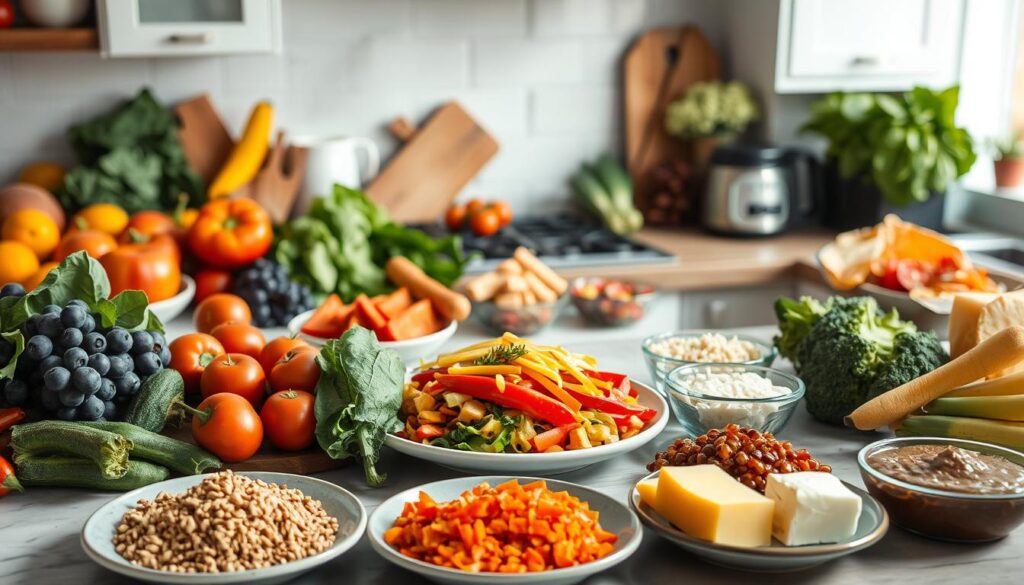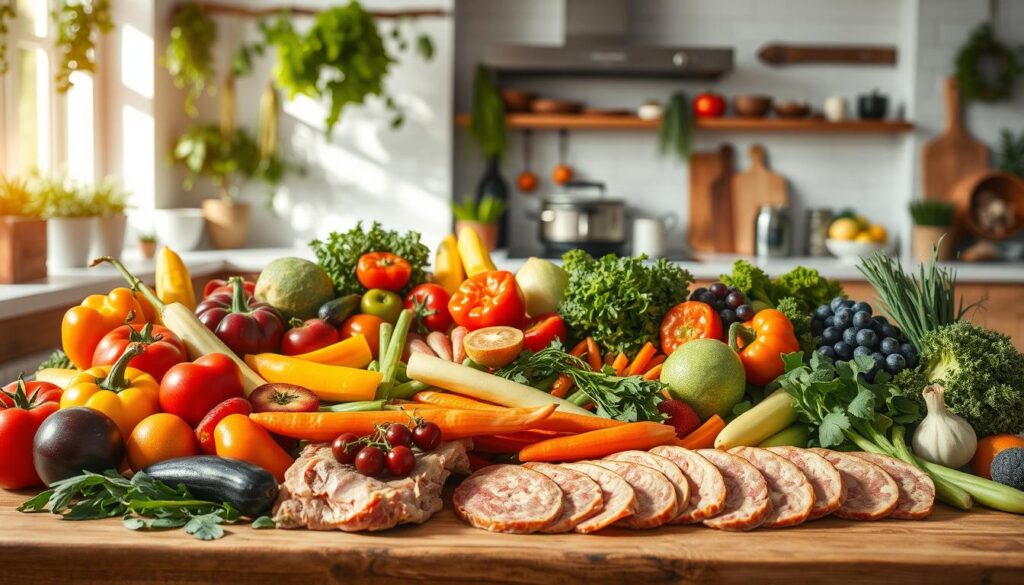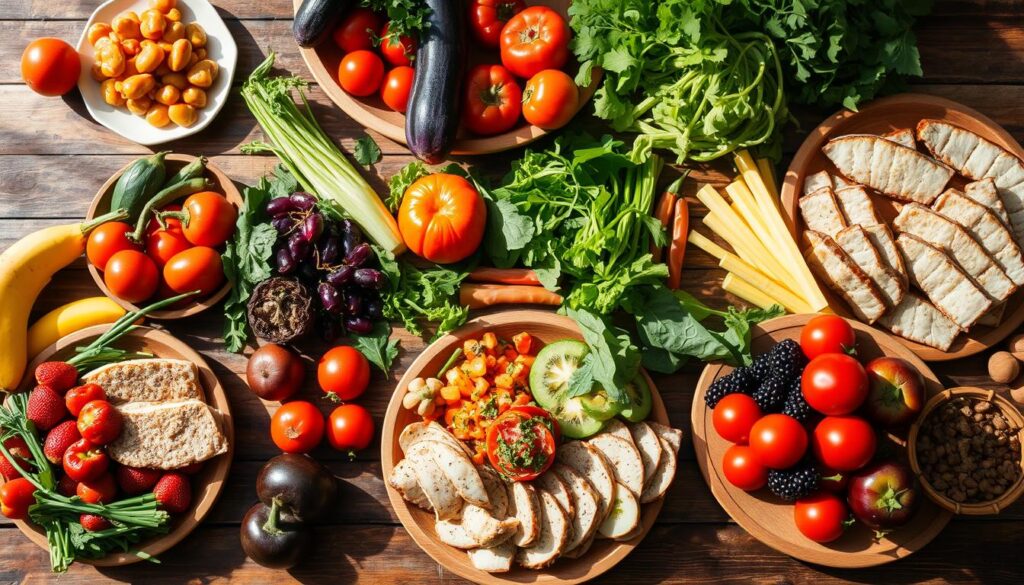The Whole30 diet is a 30-day plan to find food sensitivities and better eating habits. It helps you feel good about food. This guide will cover the main rules and tips for a successful Whole30 journey.
The Whole30 diet focuses on eating real foods and avoiding certain groups. These foods might cause inflammation or cravings. By following strict rules for 30 days, you can reset your body and habits. You might also find foods you’re sensitive to.
Key Takeaways
- The Whole30 diet is a 30-day elimination program focused on identifying food sensitivities and establishing healthier eating habits.
- It involves eliminating grains, legumes, dairy, added sugars, and processed foods, while encouraging the consumption of whole, unprocessed foods.
- Meal preparation and the use of kitchen gadgets are crucial for navigating the dietary guidelines during the Whole30 program.
- Participants often experience weight loss, improved skin health, and increased energy levels upon completing the Whole30 program.
- Reintroducing restricted food groups one by one is an essential part of the 42-day Whole30 program, allowing individuals to identify personal food sensitivities.
Understanding the Whole30 Diet Program Basics
The Whole30 program is a 30-day plan. It helps you eat whole, simple foods. It started in 2009 and focuses on how food affects you, not if it’s good or bad.
Origins and Philosophy
The Whole30 program removes certain foods for 30 days. It helps you find out if you have food sensitivities. It’s not just for losing weight, but for a healthier life and better food choices.
Core Program Structure
The Whole30 program has a clear plan. First, you follow a 30-day elimination phase. Then, you slowly add foods back in. This 30-day plan is not too long or too short for most people.
Duration and Timeline
It takes 66 days to make a habit stick. But Whole30 shows big changes in just 30 days. You can see weight loss, better health, and a new way of eating without feeling stressed.
“Whole30 emphasizes a focus on feeling better overall rather than just weight management, promoting a healthier relationship with food and not tracking calories.”
Whole 30 Diet Rules: Essential Guidelines for Success
The Whole30 program has clear rules for a 30-day diet. Following these rules is key to getting the most out of it. It helps you reset your relationship with food.
Here are the main rules to follow:
- Eliminate all added sugars, artificial sweeteners, and processed foods from your diet for 30 days.
- Avoid grains, legumes, dairy, and processed meats during the elimination phase.
- Do not step on the scale or take body measurements throughout the 30 days.
- Refrain from recreating baked goods, treats, or junk food using Whole30-approved ingredients (the “Pancake Rule”).
It’s very important to stick to these rules. Even a little bit of the forbidden foods can mess up the reset. It can stop the healing and change you want.
| Whole30 Diet Rule | Rationale |
|---|---|
| Eliminate added sugars, artificial sweeteners, and processed foods | To reduce inflammation, reset taste buds, and break unhealthy dependencies |
| Avoid grains, legumes, dairy, and processed meats | These food groups can trigger digestive issues or sensitivities in many people |
| Do not weigh yourself or take measurements | To avoid obsessing over the scale and focus on non-scale victories |
| No “Whole30 treats” or baked goods | To prevent recreating unhealthy habits and emotional attachments to food |
Following the whole 30 diet rules and whole30 guidelines is crucial. It helps you get the most out of the whole30 tips. This way, you can fully enjoy the benefits of the Whole30 program.
“The Whole30 is not a ‘diet’ in the traditional sense – it’s a short-term nutrition reset, designed to help you put an end to unhealthy cravings and habits, restore a healthy metabolism, heal your digestive tract, and balance your immune system.”
Foods to Eliminate During Whole30
The Whole30 diet is a 30-day challenge. It helps improve gut health and reduce inflammation. Knowing which foods to avoid is key.
Added Sugars and Artificial Sweeteners
The Whole30 diet bans added sugars and artificial sweeteners. This includes table sugar, honey, maple syrup, and agave. It also excludes artificial sweeteners in diet sodas and processed foods.
Grains and Legumes
Grains like wheat, rice, and corn are not allowed. Legumes, including beans and peanuts, are also off-limits. These foods can cause inflammation and digestive problems for some.
Dairy Products
Dairy products, like milk, cheese, and yogurt, are not part of the Whole30 diet. The goal is to check for sensitivities or intolerances.
Processed Foods
The Whole30 diet focuses on whole, unprocessed foods. This means no baked goods, snacks, or packaged meals during the challenge.
By avoiding these foods, the Whole30 diet helps find food sensitivities or inflammation. This leads to better gut health and overall well-being. The Whole30 guidelines and paleo Whole30 are for a nourishing and transformative experience.
Approved Foods on the Whole30 Program
The Whole30 diet focuses on eating whole, unprocessed foods. This helps keep you healthy and happy. You’ll find many foods you can eat on the Whole30 diet. Here are some:
- Meat: Grass-fed beef, pasture-raised chicken, and wild-caught fish
- Seafood: Salmon, tuna, shrimp, and other seafood options
- Eggs: From pasture-raised hens
- Vegetables: A wide range of fresh, frozen, or canned vegetables
- Fruits: Apples, berries, citrus fruits, and other fresh or frozen fruits
- Healthy fats: Olive oil, coconut oil, avocado oil, and nut butters
- Herbs, spices, and seasonings: To add flavor to your meals
The Whole30 diet doesn’t let you eat grains, legumes, dairy, or added sugars. But, there are some exceptions. You can use fruit juice as a sweetener, coconut aminos instead of soy sauce, and alcohol-based extracts for flavor. Iodized salt is okay too.
By eating whole foods, the Whole30 program helps your body reset. It aims to lower inflammation and boost your health. Choose fresh, quality ingredients to nourish your body and support your Whole30 journey.
Meal Planning and Preparation Strategies
Doing well on the whole30 meal plan needs good meal planning and prep. A weekly meal plan helps you stay on track. It makes sure you eat all the whole30 recipes you need. Also, a detailed whole30 shopping list makes grocery shopping easy and meal prep simple.
Weekly Meal Template
Plan your meals for the week first. Think about breakfast, lunch, and dinner for each day. Use whole30 recipes with proteins, veggies, fruits, and healthy fats. Spend some time on the weekend to prep meals for the week. This makes weekdays easier.
Shopping List Essentials
- Protein sources: Meat, poultry, eggs, seafood
- Vegetables: A wide assortment of fresh, frozen, and canned options
- Fruits: Seasonally available and frozen varieties
- Healthy fats: Avocado, olive oil, nuts, and seeds
- Herbs and spices to flavor your whole30 recipes
Meal Prep Tips
- Batch cook proteins, such as chicken or ground meat, to use throughout the week.
- Pre-chop and store vegetables in the refrigerator for easy meal assembly.
- Have a stash of compliant snacks on hand, like hard-boiled eggs, carrot sticks, and nut butter.
- Invest in kitchen tools that make meal prep more efficient, like a good chef’s knife and a steamer basket.
With a bit of planning and prep, you can do great on the whole30 diet. It’s a big commitment, but it’s worth it for better energy and health.
“The Whole30 requires a significant amount of meal preparation and planning.”
– Sarah Steffens, LA-based personal chef
Understanding the Reintroduction Phase
The whole30 reintroduction phase is key in the Whole30 program. It lets you slowly add back foods you cut out at first. This helps find out if you’re sensitive to certain foods.
This phase lasts 10 days or more. You add back one food group at a time. You take 2-3 days off from whole30 guidelines between each food group. This way, you can see how each food affects you.
The order of adding back foods is planned. It starts with foods like added sugars. Then it moves to foods like dairy and gluten. This helps you figure out which foods bother you.
| Reintroduction Schedule | Duration |
|---|---|
| Added Sugars | 1-2 days |
| Non-Gluten Grains | 1-2 days |
| Dairy | 1-2 days |
| Gluten-Containing Grains | 1-2 days |
| Alcohol | 1-2 days |
It’s important to write down how each food makes you feel. Note changes in energy, sleep, and mood. This helps you decide which foods to keep eating.

The whole30 reintroduction phase teaches you about food and your body. It helps you make a diet plan that’s good for you.
Common Challenges and How to Overcome Them
The Whole30 program is a big change. It has its tough parts. You might face cravings, social challenges, and tricky food labels. Here are some Whole30 tips to help you get past these hurdles and keep going.
Dealing with Cravings
Missing out on foods like sugar can make you really want them. Here’s how to handle it:
- Have Whole30-approved snacks ready, like fruit, nuts, or veggie sticks with guacamole.
- Drink lots of water and herbal tea to fight cravings.
- Do something active or find something else to think about.
- Remember why you started the Whole30 challenges in the first place.
Navigating Social Situations
Going out to eat or to parties can be hard on the Whole30. Here’s how to handle it:
- Suggest Whole30-friendly places or offer to host.
- Bring a dish that fits the Whole30 rules so you can eat something.
- Say no to foods and drinks that aren’t Whole30 and don’t explain.
- Enjoy the company and the event, not just the food.
Reading Food Labels
It’s key to know what’s in your food on the Whole30. Learn to spot hidden sugars, additives, and other no-go ingredients by:
| Ingredient to Avoid | Potential Names |
|---|---|
| Sugar | Cane sugar, brown sugar, honey, maple syrup, agave, etc. |
| Dairy | Milk, cheese, yogurt, butter, cream, etc. |
| Grains | Wheat, rice, oats, barley, corn, etc. |
| Legumes | Beans, peanuts, soy, etc. |
With practice, you’ll get better at the Whole30. You’ll be ready for success.
Benefits and Expected Results
If you’re thinking about the whole30 benefits, you’re in for a treat. The Whole30 program is more than a diet. It’s a lifestyle change that can improve your health and how you feel about food. You might see whole30 weight loss, more energy, and better sleep.
One big whole30 result is better digestion. By avoiding foods like dairy and grains, you can feel less bloated. Many people say they have regular bowel movements and easier weight management after Whole30.
- Reduced inflammation and improved gut health
- Increased energy and better sleep
- Clearer skin and reduced acne
- Improved focus and mental clarity
- Healthier relationship with food and reduced cravings
The whole30 weight loss is a bonus for many. By cutting out processed foods and sugar, you can lose fat. But, the program focuses on lasting habits and a healthy mindset, not just quick weight loss.
The whole30 benefits are more than just weight loss. It helps you break bad habits and find food sensitivities. It teaches you to eat mindfully. If you want better digestion, more energy, or a healthier food relationship, Whole30 might be what you need.

Conclusion
The Whole30 program helps find food sensitivities and boosts health. It’s a 30-day diet followed by a careful adding back foods. Many people find it helps a lot, like eating better and feeling better with IBS.
Doctors see it as a fad diet because it’s very strict. There’s not much research to back it up for the long run. The rules have changed a lot, showing it needs more solid science.
Still, the Whole30 can help find food issues and make you feel better. But, do it carefully and with a doctor’s help. Knowing the rules can help you decide if it’s right for you.


A Life-Changing Experience with This Weight Loss Supplement (Nagano Tonic)
I’ve always struggled with finding a weight loss solution that actually works for me. Like many, I’ve tried numerous diets, exercise routines, and supplements over the years—some worked for a short time, but nothing ever gave me long-term results. That was until I decided to try the weight loss supplement I found : Link to the Supplement.
From the moment I started using it, I noticed a difference. Not only did I feel more energized, but my cravings also became more manageable. The best part? I started seeing results much quicker than I anticipated! Over the course of just a few weeks, I noticed a significant reduction in belly fat and overall weight loss that I hadn’t been able to achieve before.
What makes this supplement stand out from all the others I’ve tried is how it supports me in my daily routine without any jitters or energy crashes. I’m able to stay focused and motivated, which has made it easier to stay on track with my diet and exercise plan.
This product truly exceeded my expectations, and I feel more confident and healthier than ever before. If you’re struggling with your weight loss journey like I was, I highly recommend giving this supplement a try. It’s been a game-changer for me, and I’m sure it can work wonders for you too!
Contant Them on email .. tonicnagano50@gmail.com
I’ve tried so many weight loss products over the years, but nothing worked like this supplement! Since I started using it, I’ve noticed a big difference in my energy levels and appetite control. In just a few weeks, I’ve lost weight and feel so much better. It’s been easy to stick with, and the results speak for themselves. Highly recommend this to anyone looking to make a real change!
wasn’t sure what to expect, but this weight loss supplement has really impressed me! After just a few weeks of use, I’ve already dropped a few pounds and feel more motivated to stay active. It’s helped curb my cravings and boosted my energy throughout the day. I’m excited to keep going and see even better results. Definitely worth trying!
Reach them on tonicnagano50@gmail.com
I was skeptical at first, but this supplement has truly made a difference in my weight loss journey. I’ve lost weight without feeling deprived or sluggish. My cravings are under control, and I feel more confident in my body. It’s easy to incorporate into my daily routine, and the results speak for themselves. I’m so glad I gave it a try!
Thanks David, i do use the link to make my purchase. you can get too here http://surl.li/iasppy
I’ve tried so many weight loss products, but this one has been by far the most effective. In just a few weeks, I’ve noticed a visible difference in my body and energy levels. It’s helped me stay on track without the constant hunger pangs and cravings. I’m really happy with my progress and can’t wait to see where I’ll be in another month!
This Nagano Tonic has been amazing! In just a few weeks, I’ve lost weight, feel more energized, and my cravings are under control. Highly recommend it!
Thats the link to purchase http://surl.li/iasppy